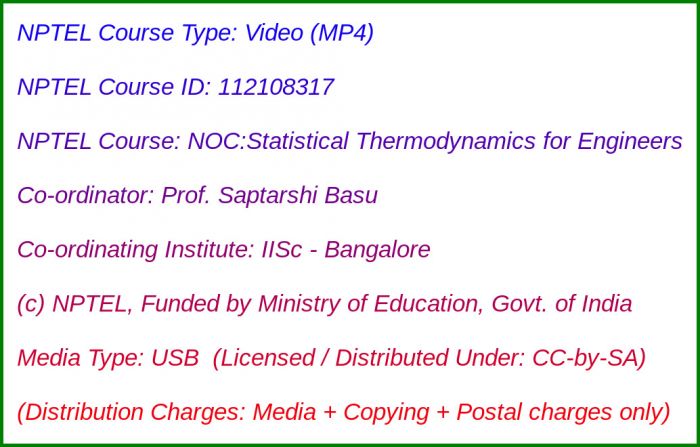
Media Storage Type : 32 GB USB Stick
NPTEL Subject Matter Expert : Prof. Saptarshi Basu
NPTEL Co-ordinating Institute : IISc Bangalore
NPTEL Lecture Count : 59
NPTEL Course Size : 3.6 GB
NPTEL PDF Text Transcription : Available and Included
NPTEL Subtitle Transcription : Available and Included (SRT)
Lecture Titles:
Lecture 1 - Introduction to Statistical Thermodynamics
Lecture 2 - Basic Probability Theory and Statistics
Lecture 3 - Important Probability Distributions
Lecture 4 - Combinatorial Analysis for Statistical Thermodynamics
Lecture 5 - Basic Concepts
Lecture 6 - Macrostates and Microstates
Lecture 7 - Bose Einstein and Fermi Dirac Statistics
Lecture 8 - Entropy and the equilibrium particle distribution
Lecture 9 - Operator Theory - 1
Lecture 10 - Stirling Approximation and Lagrange Multipliers
Lecture 11 - Equilibrium particle distribution
Lecture 12 - The Dilute Limit and Concept of Molecular Partition Function
Lecture 13 - The Molecular Partition Function and its relationship with Classical Thermodynamics
Lecture 14 - Historical Survey of Quantum Mechanics
Lecture 15 - Operator Theory - 2
Lecture 16 - Operator Theory - 3
Lecture 17 - Bohr Model for the Spectrum of Atomic Hydrogen
Lecture 18 - Heuristic Introduction to the Schrodinger Equation
Lecture 19 - The postulates of Quantum Mechanics
Lecture 20 - The Steady State Schrodinger Equation: Single Particle Analysis
Lecture 21 - Coordinate System - 1
Lecture 22 - Coordinate System - 2
Lecture 23 - Coordinate System - 3
Lecture 24 - The Steady State Schrodinger Equation: Multiparticle analysis
Lecture 25 - The Particle in a Box
Lecture 26 - The Uncertainity Principle
Lecture 27 - The Pauli Exclusion and the Correspondence Principle
Lecture 28 - Problem Solving - 1
Lecture 29 - Problem Solving - 2
Lecture 30 - The Internal Motion for a two particle system
Lecture 31 - The rotational and vibrational energy mode for a diatomic molecule
Lecture 32 - Hermite polynomials as vibrational energy mode solution
Lecture 33 - Equivalent two body model of atomic hydrogen
Lecture 34 - The Electronic Energy Mode for Atomic Hydrogen
Lecture 35 - Problem Solving - 3
Lecture 36 - The four quantum numbers and multielectron systems
Lecture 37 - Spectroscopic term symbols for multielectron atoms
Lecture 38 - Electron energies for multielectron systems
Lecture 39 - Combined energy modes for atoms and diatomic molecules
Lecture 40 - Perturbation analysis of the Schrodinger Wave equation
Lecture 41 - Selection rules
Lecture 42 - The Rotational and vibrational spectroscopy
Lecture 43 - Ro-vibrational spectroscopy (Simplex model)
Lecture 44 - Rotation vibration coupling (Complex model)
Lecture 45 - Ro-vibrational spectroscopy (Complex model)
Lecture 46 - Ro-vibronic spectroscopy
Lecture 47 - Working with Spectroscopic Schemes, Notations and Term Symbols
Lecture 48 - From Particles to assembly - I
Lecture 49 - From Particles to assembly - II
Lecture 50 - Connecting Quantum Mechanics to Classical Mechanics
Lecture 51 - The Equipartition principle and ideal gas
Lecture 52 - Thermodynamic properties of ideal monoatomic and diatomic gas
Lecture 53 - The zero of energy (rotational and vibrational)
Lecture 54 - Specific heats, Internal energy through Vibrational and Ro-vibrational energy modes
Lecture 55 - The Ro-vibrational partition function and Introduction to intersction of Radiationand Matter
Lecture 56 - Absorption and Emission of Radiation
Lecture 57 - The Rabi frequency and Beer's Law
Lecture 58 - Insights into radiative spectral transitions
Lecture 59 - Theory of Absoprtion Spectroscopy

